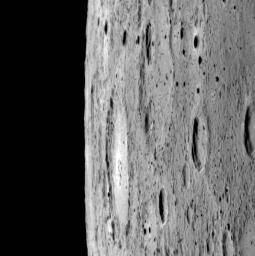
|
In High Phase
- Click the image above for a larger view
- Full-Res JPEG (1020 x 1024) (122.3 kB)
- Full-Res TIFF (1020 x 1024) (1.0 MB)
Caption:
Looking toward the horizon, you get a sense of what it might be like to ride along with MESSENGER, taking in the view. In this look at the limb, the large crater near the center is approximately 110 km (68 miles) across. Because the angle between the Sun and the spacecraft is large (a phase angle of 141.6°), we see only the shadowed walls of most small craters, giving the surface a speckled appearance.
This image was acquired as part of MDIS's limb imaging campaign. Once per week, MDIS captures images of Mercury's limb, with an emphasis on imaging the southern hemisphere limb. These limb images provide information about Mercury's shape and complement measurements of topography made by the Mercury Laser Altimeter (MLA) of Mercury's northern hemisphere.
Date acquired:
July 16, 2013
Image Mission Elapsed Time (MET):
16312930
Image ID:
4453973
Instrument:
Narrow Angle Camera (NAC) of the Mercury Dual Imaging System (MDIS)
Center Latitude:
-49.77°
Center Longitude:
352.9° E
Resolution:
183 meters/pixel
Scale:
The bright crater at center is approximately 110 km (68 mi.) in diameter
Incidence Angle:
60.7°
Emission Angle:
80.9°
Phase Angle:
141.6°
Background Info:
The MESSENGER spacecraft is the first ever to orbit the planet Mercury, and the spacecraft's seven scientific instruments and radio science investigation are unraveling the history and evolution of the Solar System's innermost planet. MESSENGER acquired over 150,000 images and extensive other data sets. MESSENGER is capable of continuing orbital operations until early 2015.
For information regarding the use of images, see the MESSENGER image use policy .
Cataloging Keywords:
| Name | Value | Additional Values |
|---|---|---|
| Target | Mercury | |
| System | ||
| Target Type | Planet | |
| Mission | MESSENGER | |
| Instrument Host | MESSENGER | |
| Host Type | Orbiter | |
| Instrument | Mercury Dual Imaging System (MDIS) | |
| Detector | Narrow Angle Camera (NAC) | |
| Extra Keywords | Crater, Grayscale, Radio, Shadow | |
| Acquisition Date | ||
| Release Date | 2013-09-19 | |
| Date in Caption | 2013-07-16 | |
| Image Credit | NASA/Johns Hopkins University Applied Physics Laboratory/Carnegie Institution of Washington | |
| Source | photojournal.jpl.nasa.gov/catalog/PIA17500 | |
| Identifier | PIA17500 | |
